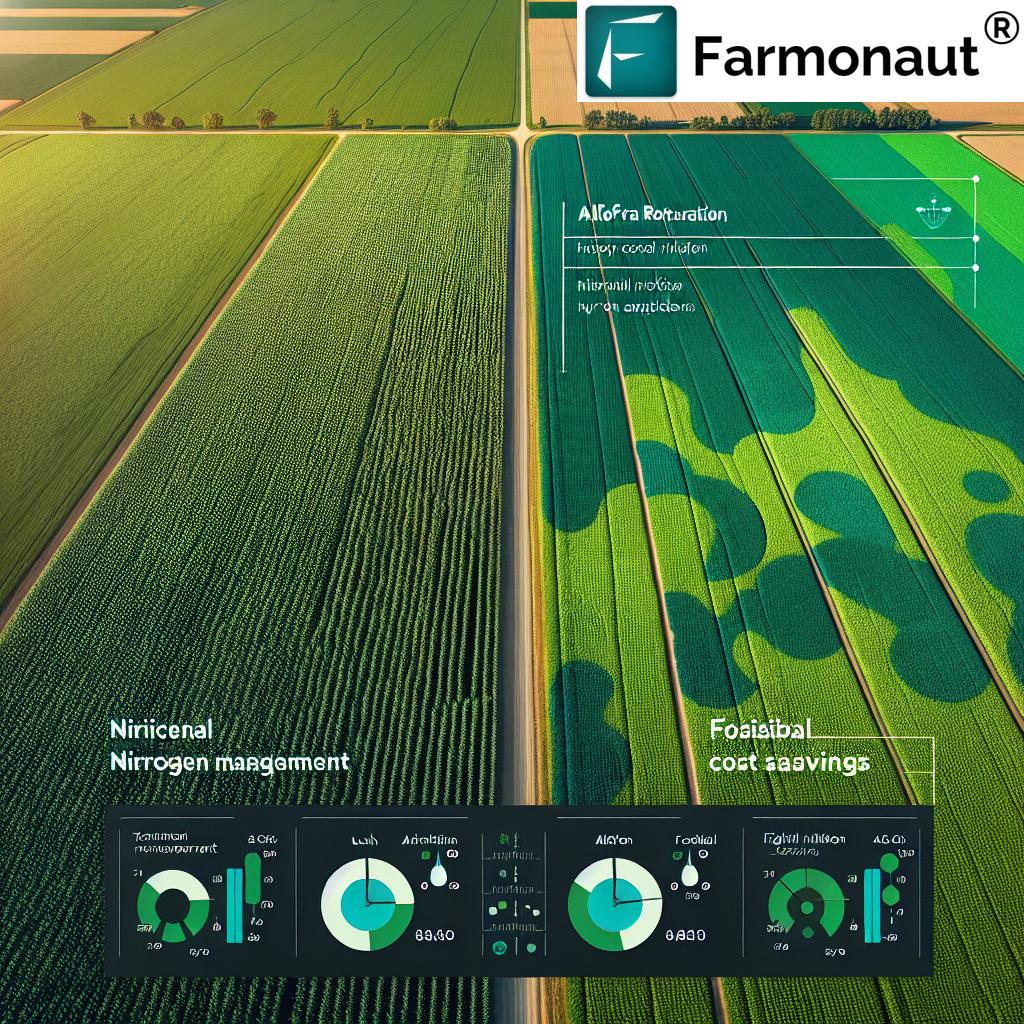Optimizing Corn Yields in Minnesota: Smart Nitrogen Management After Alfalfa for Sustainable Farming
“Research shows up to 95% of cornfields following alfalfa may not require additional nitrogen, potentially saving farmers thousands of dollars.”
Welcome to our comprehensive guide on optimizing corn yields in Minnesota through smart nitrogen management after alfalfa. As we delve into this crucial topic, we’ll explore how sustainable farming practices and innovative strategies can lead to significant cost savings and improved crop production for Midwest farmers.
In recent years, the agricultural landscape has been evolving rapidly, with a growing emphasis on sustainability and economic efficiency. At Farmonaut, we’re committed to providing farmers with cutting-edge tools and insights to make informed decisions about their crops. Our satellite-based farm management solutions offer real-time data on crop health, soil moisture, and other vital metrics, empowering farmers to optimize their resource usage and maximize yields.

The Importance of Nitrogen Management in Corn Production
Nitrogen is a critical nutrient for corn growth and development. Proper nitrogen management is essential for achieving optimal yields while minimizing environmental impact and production costs. In the context of corn production following alfalfa, understanding the nitrogen contribution from the previous alfalfa crop is crucial for developing an effective fertilization strategy.
Recent research has revealed a surprising fact: many cornfields following alfalfa rarely require additional nitrogen. This finding challenges conventional recommendations and highlights the potential for significant cost savings in Midwest farming operations.
Alfalfa Nitrogen Credits: A Game-Changer for Corn Producers
Alfalfa, a legume crop, has the unique ability to fix atmospheric nitrogen in the soil through symbiotic relationships with bacteria. This process results in what we call “alfalfa nitrogen credits” – the amount of nitrogen left in the soil after an alfalfa crop that can be utilized by the subsequent corn crop.
“Alfalfa can contribute up to 190 lbs of nitrogen per acre, reducing the need for synthetic fertilizers in subsequent corn crops.”
Understanding and leveraging these alfalfa nitrogen credits is key to optimizing corn nitrogen management. By accurately accounting for this natural nitrogen source, farmers can significantly reduce their reliance on synthetic fertilizers, leading to both economic and environmental benefits.
Factors Affecting Nitrogen Requirements in Corn After Alfalfa
Several factors play crucial roles in determining the nitrogen requirements for corn following alfalfa:
- Soil Texture: The type of soil (sandy, loamy, or clay) affects nitrogen retention and availability.
- Environmental Conditions: Factors such as rainfall, temperature, and growing season length impact nitrogen mineralization and crop uptake.
- Alfalfa Stand Age: Older alfalfa stands generally contribute more nitrogen to the soil.
- Alfalfa Stand Density: Denser stands typically provide higher nitrogen credits.
At Farmonaut, our advanced satellite imaging technology can help farmers assess these factors more accurately. By providing detailed insights into soil conditions and crop health, we enable farmers to make data-driven decisions about their nitrogen management strategies.
Reassessing Conventional Nitrogen Recommendations
Traditional guidelines for nitrogen application in corn after alfalfa may be overly conservative. Many farmers have been applying more nitrogen than necessary, leading to unnecessary expenses and potential environmental issues. It’s time to reassess these recommendations based on the latest research and data.
Here’s a comparison of conventional and optimized nitrogen management strategies:
| Soil Texture | Alfalfa Stand Age | Estimated Alfalfa N Credit (lbs N/acre) | Conventional N Recommendation (lbs N/acre) | Optimized N Recommendation (lbs N/acre) | Potential N Savings (lbs N/acre) | Estimated Cost Savings ($/acre) |
|---|---|---|---|---|---|---|
| Sandy | 1 year | 100 | 150 | 50 | 100 | $50 |
| Loamy | 2 years | 140 | 120 | 0-30 | 90-120 | $45-$60 |
| Clay | 3+ years | 180 | 100 | 0 | 100 | $50 |
As the table demonstrates, optimizing nitrogen management can lead to substantial savings without compromising yield potential.
Economic Impact of Reducing Nitrogen Application
The economic benefits of optimizing nitrogen application in corn after alfalfa are substantial, especially in times of lower crop prices. By reducing unnecessary fertilizer use, farmers can:
- Lower input costs
- Improve profit margins
- Enhance overall farm sustainability
For example, a farmer managing 1,000 acres of corn following alfalfa could potentially save $50,000 or more annually by optimizing nitrogen application based on accurate alfalfa nitrogen credits.
Leveraging Technology for Precision Nitrogen Management
At Farmonaut, we understand the importance of precision in modern agriculture. Our satellite-based crop monitoring system provides farmers with real-time data on crop health, allowing for more accurate nitrogen management decisions. By integrating this technology into your farming practices, you can:
- Monitor crop nitrogen status throughout the growing season
- Identify areas of nitrogen deficiency or excess
- Make targeted nitrogen applications as needed
- Reduce overall nitrogen use while maintaining or improving yields
Our Jeevn AI Advisory System goes a step further by analyzing satellite data and other inputs to generate customized advice on nitrogen management, helping you optimize your corn production strategy for improved farm economics and environmental sustainability.
Explore Farmonaut’s API for advanced data integration
Best Practices for Nitrogen Management in Corn After Alfalfa
To optimize your nitrogen management strategy for corn following alfalfa, consider these best practices:
- Soil Testing: Conduct regular soil tests to assess nitrogen levels and other nutrient needs.
- Alfalfa Stand Evaluation: Assess the age and density of your alfalfa stand to estimate nitrogen credits accurately.
- Weather Monitoring: Consider weather patterns and their potential impact on nitrogen availability and crop uptake.
- Split Applications: If additional nitrogen is needed, consider split applications to improve efficiency and reduce losses.
- Use of Cover Crops: Implement cover crops to help manage nitrogen levels and improve soil health.
- Precision Application Technologies: Utilize variable-rate technology for more precise nitrogen application based on field variability.
By implementing these practices and leveraging Farmonaut’s advanced monitoring tools, you can optimize your corn yields while minimizing environmental impact and maximizing profitability.
Environmental Benefits of Optimized Nitrogen Management
Beyond the economic advantages, optimizing nitrogen management in corn after alfalfa offers significant environmental benefits:
- Reduced nitrogen leaching into groundwater
- Decreased greenhouse gas emissions from excess fertilizer use
- Improved soil health and microbial activity
- Enhanced biodiversity in and around agricultural fields
By adopting sustainable farming practices and leveraging technology like Farmonaut’s satellite-based monitoring, farmers can play a crucial role in environmental stewardship while maintaining profitable operations.

The Role of Data in Optimizing Corn Production
In today’s digital age, data-driven decision-making is key to successful farming. Farmonaut’s platform provides farmers with valuable data on:
- Crop health indices (e.g., NDVI)
- Soil moisture levels
- Weather patterns and forecasts
- Historical field performance
By analyzing this data, farmers can make more informed decisions about nitrogen management and other aspects of corn production. Our AI-powered advisory system helps interpret this data, providing actionable insights tailored to your specific field conditions.
Future Trends in Nitrogen Management for Corn Production
As we look to the future of agriculture, several trends are likely to shape nitrogen management in corn production:
- Advanced Sensors: Developments in sensor technology will allow for even more precise monitoring of crop nitrogen status.
- Machine Learning: AI and machine learning algorithms will continue to improve, providing more accurate predictions and recommendations.
- Biological Nitrogen Fixation: Research into enhancing biological nitrogen fixation in non-legume crops could revolutionize nitrogen management.
- Climate-Smart Agriculture: Increasing focus on climate-resilient farming practices will influence nitrogen management strategies.
At Farmonaut, we’re committed to staying at the forefront of these technological advancements, ensuring that our platform continues to provide cutting-edge solutions for farmers.
Check out our API Developer Docs for integration possibilities
Conclusion: Embracing Smart Nitrogen Management for Sustainable Success
Optimizing nitrogen management in corn after alfalfa represents a significant opportunity for Minnesota farmers to improve their bottom line while contributing to environmental sustainability. By leveraging alfalfa nitrogen credits, adopting precision agriculture technologies, and making data-driven decisions, farmers can achieve optimal corn yields with reduced input costs.
As we continue to face challenges such as climate change and economic pressures, smart nitrogen management will play an increasingly crucial role in ensuring the resilience and profitability of Midwest farms. At Farmonaut, we’re proud to support farmers in this journey towards more sustainable and efficient agricultural practices.
Remember, every field is unique, and optimizing your nitrogen management strategy may require some experimentation and fine-tuning. By staying informed, leveraging technology, and adapting to new research findings, you can position your farm for long-term success in an ever-changing agricultural landscape.
FAQ Section
Q: How much nitrogen can alfalfa contribute to the following corn crop?
A: Alfalfa can contribute up to 190 lbs of nitrogen per acre, depending on factors such as stand age, density, and soil conditions.
Q: Do I always need to apply additional nitrogen to corn following alfalfa?
A: Not necessarily. Recent research suggests that up to 95% of cornfields following alfalfa may not require additional nitrogen.
Q: How can I determine the nitrogen credit from my alfalfa crop?
A: Factors to consider include alfalfa stand age, density, soil texture, and environmental conditions. Soil testing and professional consultation can help provide more accurate estimates.
Q: Will reducing nitrogen application affect my corn yields?
A: When done correctly, optimizing nitrogen application based on alfalfa credits should not negatively impact yields. In fact, it can lead to more efficient nutrient use and potentially improved crop health.
Q: How can Farmonaut help me optimize my nitrogen management?
A: Farmonaut’s satellite-based crop monitoring and AI advisory system provide real-time data on crop health and personalized recommendations, helping you make informed decisions about nitrogen management and other aspects of crop production.
By embracing smart nitrogen management and leveraging innovative technologies like those offered by Farmonaut, Minnesota farmers can lead the way in sustainable, profitable corn production. Together, we can build a more resilient and environmentally friendly agricultural future.




